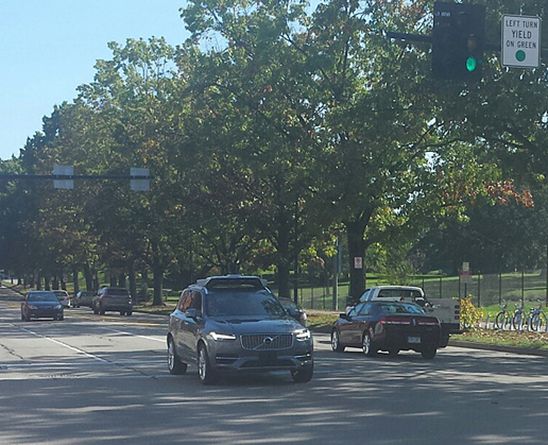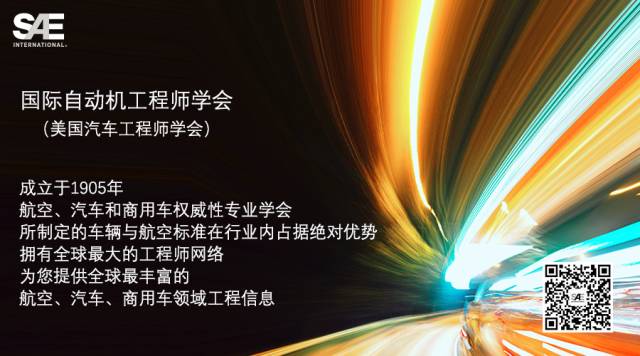 目前,尽管全美各地的自行驾驶技术研发与测试均在如火如荼地进行之中,但相关联邦机动车安全标准却尚未完全跟上,无法为此类新型汽车发展提供所需的支持,比如图中这辆行驶在宾夕法尼亚州匹兹堡市内的自动驾驶优步车辆。
目前,尽管全美各地的自行驾驶技术研发与测试均在如火如荼地进行之中,但相关联邦机动车安全标准却尚未完全跟上,无法为此类新型汽车发展提供所需的支持,比如图中这辆行驶在宾夕法尼亚州匹兹堡市内的自动驾驶优步车辆。
如果说自动驾驶必将成为未来交通运输领域的关键字,那么当这些新型汽车真正开始上路时,相关测试标准和法律规定也必须同步就位,保证所有共同道路用户的安全。
2017 年9 月初,在民主、共和两党的共同努力下,美国众议院一致通过了由 Robert Latta 议员(R-OH) 发起的《自动驾驶法案(SELF DRIVE ACT) 》,旨在顺利实现自动驾驶汽车的安全部署与相关研究。
H.R. 3388《自动驾驶法案》是全美首部旨在确保自动驾驶汽车的安全创新、研发、测试及部署的专门法案。目前,无论是硅谷的技术公司,还是底特律的传统汽车厂商,全美各地的自动驾驶技术研发与测试都在如火如荼地进行着,但相关联邦机动车安全标准却尚未完全跟上,无法为此类新型汽车发展提供所需的支持。
此外,美国参议院提出了一项并行法案,是由共和党大会主席 John Thune (R-SD) 发起的《美国通过革命性技术提高安全运输的愿景(AV START)法案》,也正在讨论中,尚未进入投票环节。
最终,国会将结合Self Drive和AV START两部法案的内容,制定为一部专门法律,迎接很快将成为现实的自动驾驶汽车时代。
此外,美国交通运输部 (DOT) 及国家公路交通安全管理局(NHTSA) 曾在 9 月 12 日发布了一份有关自动驾驶指南的重要更新,即出台了一份名为《自动驾驶系统:安全愿景 2.0》的非强制性自动驾驶汽车开发准则(点击此处了解详情)。
这三项行动有助于为自主驾驶的未来奠定基础,但他们均有一个共同点,即全部引用了由SAE International 在2016年9月份发布的SAE J3016 操作规程《道路机动车驾驶自动化系统相关术语分类和定义》
根据美国众议院能源和商业委员会 (E&C) 网站https://energycommerce.house.gov/selfdrive/ 的介绍,《自动驾驶法案》将以保护消费者为核心,并逐步推动安全性的提升;重申联邦政府和州政府的作用和责任;更新联邦机动车辆安全标准,全面覆盖技术进步和车辆高度自动化所带来的变化;尽可能开发美国的相关研发机遇,创造更多就业机会;培育经济发展机会,确保美国在自动驾驶领域保持全球领先地位。
《自动驾驶法案》全文请见:https://www.congress.gov/bill/115thcongress/house-bill/3388/text。
参议院的《AV START法案(S. 1885) 》与众议院《自动驾驶法案》有不少相似之处。其中,AV START法案旨在“支持高度自动驾驶汽车安全技术的发展,及其他相关目标的实现”。
AV START法案强调要加强安全监督力度;强化联邦、各州和地方政府的作用;消除部署障碍;维持卡车和公共汽车的现状保持不变;加速现有规章制度修订;加强网络安全;建立专家委员会以开发制定汽车安全和数据分享相关标准(包括数据记录、访问及共享等方面);强化消费者教育,并改善残疾人的出行环境等。
“AV START 法案”内容请见:https://www.congress.gov/bill/115th-congress/senate-bill/1885/text。
美国交通运输部表示,《安全愿景2.0》是美国自动驾驶系统方面的最新指导政策,并非强制性标准,具体内容包括:
-
专注 SAE 3 到5 级自动驾驶系统,即有条件自动驾驶、高度自动驾驶和完全自动驾驶系统;
-
澄清监管流程,明确各企业无需等待,可以立即开始自动驾驶系统的测试与部署;
-
从安全自我评估中剔除不必要的无关设计元素;
-
对比最新发展和行业术语,对联邦指导文件进行同步更新;
-
明确联邦政府和州政府将在未来自动驾驶系统发展中各自扮演的角色。
《安全愿景 2.0》全文请点击 https://www.nhtsa.gov/sites/nhtsa.dot.gov/files/documents/13069a-ads2.0_090617_v9a_tag.pdf.
继9 月 12 日美国交通运输部发布有关自动驾驶的最新通知后,美国能源与商业委员会主席 Greg Walden (R-OR) 和数字商务与消费者保护小组委员会主席 Bob Latta (R-OH) 也发布声明表示,“众议院将排除万难,团结民主党和共和党,坚定不移地推动《自动驾驶法案》的通过,为自动驾驶汽车和先进避撞技术的发展铺平道路。得知美国交通部长赵小兰部长在交通运输的安全、创新及确保美国长期处于行业领先地位等方面与我们持相同看法,我们非常高兴。我们呼吁参议院积极采取行动,尽快推动白宫将自动驾驶汽车法案纳入法律体系。”
根据美国能源和商业委员会的消息,《自动驾驶法案》将提高美国国家公路交通安全管理局采纳新兴技术安全标准的能力,并明确联邦和各州政府在自动驾驶汽车管理方面应发挥的作用。
我们会继续关注,为您带来后续报道。
If the future of driving is autonomous, testing and legislation must be in accord to assure public safety when autonomous vehicles (AVs) begin to deploy.
In early September, thanks to a bipartisan effort to develop legislation for self-driving or autonomous vehicles (AVs), the U.S. House of Representatives unanimously passed a bill sponsored by Rep. Robert Latta (R-OH) known as the SELF DRIVE (Safely Ensuring Lives Future Deployment and Research in Vehicle Evolution) Act.
H.R. 3388 (SELF DRIVE Act) is first-of-its-kind legislation to ensure the safe and innovative development, testing, and deployment of self-driving cars. While self-driving technology is currently being developed and tested across the country, from the Silicon Valley to Detroit, federal motor vehicle safety standards need to be updated to address vehicles lacking traditional design features.
A parallel bill has been introduced by the U.S. Senate and sponsored by Senator John Thune (R-SD) called AV START (the American Vision for Safer Transportation Through Advancement of Revolutionary Technologies) Act. Discussions on this bill are ongoing with a vote yet to occur.
Ultimately, there will be a compromised bill based on the two—SELF DRIVE and AV START—that will be enacted into law to prepare for the deployment of AVs in the not-so-distant future.
Also in self-driving regulations news, the U.S. Dept. of Transportation (DOT) and its National Highway Traffic Safety Administration (NHTSA) introduced on September 12 (see articles.sae.org/15625/) an update to its autonomous driving guidelines with the release of a new voluntary-guidelines document for autonomous-vehicle development called “Automated Driving Systems 2.0: A Vision for Safety.”
These three actions can help lay the groundwork for the future of autonomous driving—and all three have a common denominator: SAE’s Recommended Practice J3016 Taxonomy and Definitions for Terms Related to Driving Automation Systems for On-Road Motor Vehicles, which was published in September 2016, is referenced in each.
According to the U.S. House Energy and Commerce (E&C) Committee’s website, (https://energycommerce.house.gov/selfdrive/), the SELF DRIVE Act will advance safety by prioritizing the protection of consumers; reaffirm the role and responsibilities of federal and state governments; update the Federal Motor Vehicle Safety Standards to account for advances in technology and the evolution of highly automated vehicles; and maximize opportunities for research and development in the U.S. to create jobs and grow economic opportunities so that America can remain a global leader in this industry.
The SDA Bill can be viewed in length at https://www.congress.gov/bill/115th-congress/house-bill/3388/text.
The Senate’s AV START Act (S. 1885) contains similarities to the SELF-DRIVE Act. As stated in the introduction of the bill, it is “to support the development of highly automated vehicle safety technologies, and for other purposes.”
Highlights of AV START: provision for enhanced safety oversight; reinforces federal, state, and local roles; reduces barriers to deployment; maintains status quo for trucks and buses; brings existing rules up to speed; strengthens cybersecurity; improves vehicle safety and data sharing by establishing a committee of experts to identify and develop recommended standards (including for data recording and data access and sharing); promotes consumer education and improves mobility for Americans with disabilities.
The proposed bill can be read at: https://www.congress.gov/bill/115th-congress/senate-bill/1885/text.
As the latest guidance for automated driving systems to industry and States, the DOT said the new voluntary guidance found in “A Vision for Safety 2.0:”
- Focuses on SAE International Levels of Automation 3-5 – Automated Driving Systems (ADSs) – Conditional, High, and Full Automation)
- Clarifies the guidance process and that entities do not need to wait to test or deploy their ADSs
- Revises unnecessary design elements from the safety self-assessment
- Aligns Federal Guidance with the latest developments and industry terminology
- Clarifies Federal and State roles going forward
A full version of the document is available at: https://www.nhtsa.gov/sites/nhtsa.dot.gov/files/documents/13069a-ads2.0_090617_v9a_tag.pdf.
Following the September 12 announcement from the U.S. DOT on self-driving cars, Energy & Commerced Committee Chairman Greg Walden (R-OR) and Digital Commerce and Consumer Protection Subcommittee Chairman Bob Latta (R-OH) released a statement, “The House took strong, bipartisan action to pass the SELF DRIVE Act and pave the way for self-driving cars and advanced collision avoidance technologies. We are pleased that Secretary Chao shares our commitment to safety, innovation, and ensuring America is a leader in this growing industry. We urge the Senate to act so we can quickly get self-driving vehicle legislation to the president’s desk and signed into law,” said Walden and Latta.
According to a release from the E&C Committee, the SELF DRIVE Act “would improve the National Highway Traffic Safety Administration’s ability to adapt federal safety standards to this emerging technology, and clarify federal and state roles with respect to self-driving cars.”
We’ll keep you up to date.
Author: J. Shuttleworth
Source: SAE Automotive Engineering Magazine
等级
打分
- 2分
- 4分
- 6分
- 8分
- 10分
平均分
- 作者: J. Shuttleworth
- 行业:汽车
- 主题:
